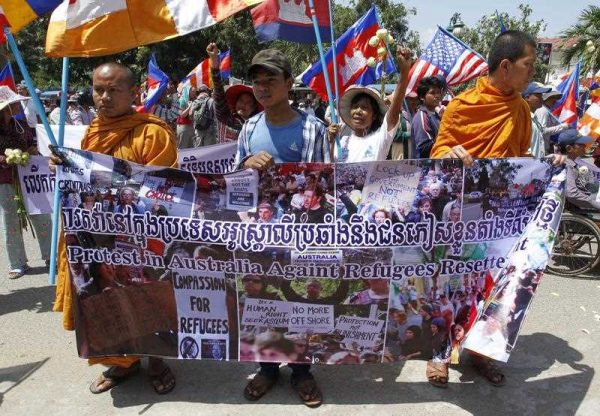The Cambodian deal has been justified by the government as part of building a regional resettlement framework. It is in fact a by-product of current policy which forbids those refugees who have come by boat to resettle in Australia. As Australia no longer permits ‘boat arrival’ refugees to settle in Australia, and because Nauru and Papua New Guinea have very limited capacity for resettling refugees, Australia must find other countries in the region who are willing (and able) to accept them.
The agreement has been widely criticised by academics and human rights organisations on the basis that Cambodia has a problematic human rights record and weak legal institutions. Others are uncomfortable with the notion that we can ‘outsource’ our refugee law obligations to a developing country.
The deal has also been the subject of concern in Cambodia, as illustrated by recent protests by Cambodian citizens. The extent to which this dissatisfaction with the plan is widespread in Cambodian society is not clear. But it does raise questions about whether the resettlement deal is sustainable, as it indicates that any refugees resettled under the arrangement may not be welcomed by at least a segment of the Cambodian population.
The main concern of Cambodians appears to be that their government has agreed to accept and care for refugees referred to them by Australia, when it cannot support its own citizens. Understandably, it is thought that the refugees should be resettled by a country more capable to provide for them, such as Australia. The Guardian reported that the Cambodians who protested the deal were concerned that Cambodia was ill-equipped to deal with refugees. Another report quoted refugee advocates in the country as saying they ‘feared locals would be upset if refugees were given money and were perceived to be better off than others in the community’.
The deal is underpinned by a large aid package from Australia of AU$40 million (US$35 million) over the next four years. It is not yet clear how these aid funds will be used and the extent to which they will benefit the Cambodian community. If deployed properly, they may alleviate some of the economic problems in the country, including poverty, food insecurity, illiteracy and unemployment. But it is widely acknowledged that corruption is widespread in the Cambodian government: Transparency International ranked Cambodia 160th of 177 in its 2013 Corruption Perceptions Index. Therefore it would seem highly unlikely that all of the funds will go to their intended projects. The Washington Post raised concerns about this in 2011, reporting that after donors pledge funds to Cambodia, ‘officials dip into the foreign aid accounts and build themselves mansions the size of small hotels’. It noted that the status of the Cambodian people the aid is supposed to help improves little if at all, with nearly 80 per cent of Cambodians living in the countryside with no electricity, clean water or toilets.
It is also possible that giving large amounts of aid to the Cambodian government may contribute to the systemic political problems in the country. An author on aid dependence in Cambodia, Sophal Ear, notes that between 2002 and 2010, Cambodia received US$5 billion in aid (representing almost 95 per cent of total government expenditure). Ear says this is important because donors enable the government to function without having to raise enough revenue through taxation and this, in turn, relieves the government of accountability to the electorate.
In addition to the AU$40 million aid package, newly settled refugees will be given financial support for the first 12 months of their residence in Cambodia (including support to start their own business). There are two main problems with this. First, this may lead to a sense of antagonism from certain segments of the Cambodian population if it gives rise to a perception that the refugees are receiving ‘special treatment’ (particularly in a situation where many Cambodians are struggling economically). Second, it is unclear how the resettled refugees will cope when that support ceases. Country information from the 2014 Human Rights Watch report suggests the resettled refugees may be at risk if they are unable to sustain themselves financially and become homeless.
Countries in Southeast Asia should be assisted to improve their refugee protection capacity as part of a regional asylum seeker framework and an asylum seeker ‘burden sharing’ regime. There are legitimate concerns about the plan to resettle refugees in Cambodia. It may therefore be wiser for the Australian government to ensure Cambodia’s refugee protection capacity is developed sufficiently, before it transfers refugees to that country for resettlement.
Maria O’Sullivan is Lecturer in the Faculty of Law at Monash University and Associate at the Castan Centre for Human Rights Law.

